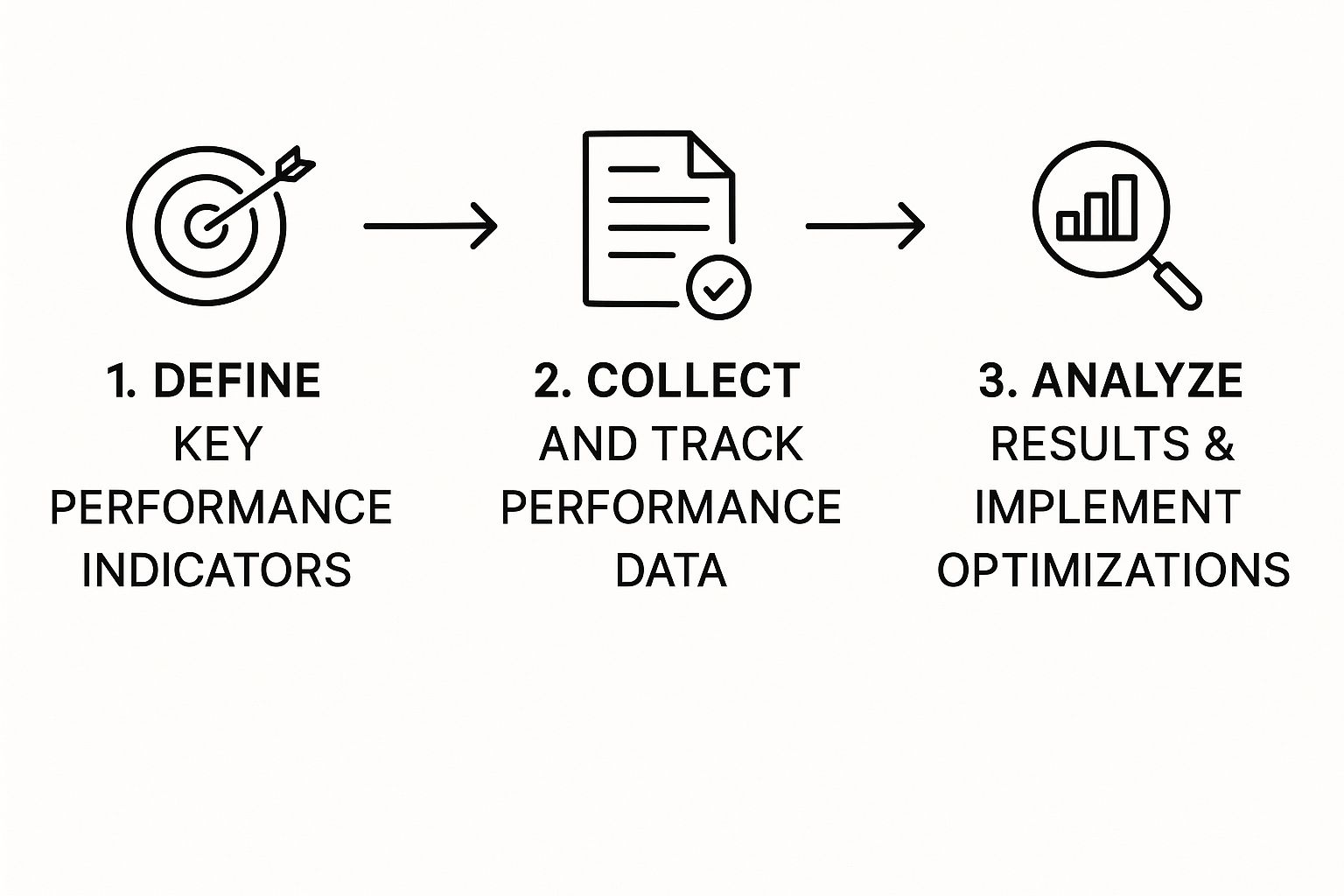Business process optimization, or BPO, is really just a formal term for something great businesses have always done: finding better, smarter ways to get work done. It’s about taking a hard look at your daily workflows and systematically making them more efficient, higher quality, and better aligned with your company's goals. Think of it not as a one-and-done project, but as a commitment to continuous improvement.
What Is Business Process Optimization Anyway?
Let’s use an analogy. Imagine your business is a professional kitchen during a dinner rush. If it's disorganized, you've got chefs bumping into each other, lost tickets, misplaced ingredients, and slow service. It's chaos. But in an optimized kitchen, every person knows their station, ingredients are prepped and ready, and dishes move like clockwork from the kitchen to the customer's table. That, in a nutshell, is business process optimization.
It’s about examining everything you do—from how you onboard a new client to how you manage inventory—and asking how it can be done better. This isn't just about slashing budgets. It’s a deeper effort to remove friction, get rid of redundant steps, and free up your team to focus on work that truly matters. When you do this right, you build a more agile company that can adapt to whatever the market throws at it.
From Disjointed Tasks to Coordinated Success
So many businesses are running on processes that weren't so much designed as they just… happened. Maybe your invoicing process involves three different spreadsheets, a lot of manual data entry, and a chain of emails just to get an approval. It probably worked fine when you were starting out, but as you scale, these cobbled-together workflows quickly turn into serious bottlenecks.
Business process optimization is about stepping back and asking some tough but necessary questions: "Why are we doing it this way?" and "What would a simpler, faster, and more reliable workflow look like?" The objective is to engineer a system where every single action serves a clear purpose and pushes you closer to your goal.
This drive for efficiency isn't just a hunch; it's a massive market trend. The global business process management (BPM) market—the technology that powers these optimization efforts—is expected to explode from roughly USD 20.84 billion in 2025 to a staggering USD 68.69 billion by 2034. Why such massive growth? It's fueled by the digitalization of work and a relentless push for productivity. In fact, about 70% of firms point to productivity and cost reduction as their main reasons for investing in this area. You can dig into more of the numbers behind these market trends on Precedenceresearch.com.
Manual vs Optimized Processes at a Glance
The difference between a clunky, manual process and a truly optimized one is night and day. One is defined by frustrating delays and unpredictable results, while the other is all about speed and reliability. This table breaks down exactly what that looks like in practice.
Looking at this comparison, it becomes crystal clear why moving from manual to optimized isn't just a nice-to-have. It’s a fundamental shift that directly impacts your bottom line, your team’s sanity, and your ability to compete.
Why Optimization Is Your New Competitive Edge

In a market that moves this fast, standing still is the same as falling behind. Let's be honest: clinging to outdated, clunky processes isn't just inefficient anymore. It’s one of the biggest risks a business can take. When your competitors are delivering faster and better, any internal friction you have becomes a huge competitive disadvantage.
Customers today expect near-instant responses and perfect execution. A slow invoicing cycle or a disorganized job schedule doesn’t just frustrate your team—it directly hurts customer satisfaction and your reputation. This is why being agile isn't a luxury anymore; it's a necessity for survival. Embracing business process optimization is how you meet these demands head-on.
Beyond the Budget Line Item
It’s easy to think of optimization as just another way to cut costs. And while trimming waste and lowering expenses are great perks, that’s just scratching the surface. The real win is building a more resilient and responsive company. A well-oiled operation gives you the power to pivot on a dime, whether you’re jumping on a new market opportunity or navigating a sudden industry storm.
This kind of operational fitness leads to real results that build a foundation for long-term success.
- Faster Market Response: Optimized companies can develop and launch services or react to customer feedback far more quickly than rivals who are stuck in the mud.
- Superior Product and Service Quality: When you refine a process, you naturally shrink the room for error. This means higher-quality work, fewer mistakes, and the kind of consistent delivery that customers remember.
- Happier, More Productive Teams: Nobody enjoys fighting with broken workflows. By eliminating those daily frustrations, you boost morale and free up your team’s brainpower to focus on valuable work, not tedious workarounds.
The Real Cost of Inaction
Think about a mid-sized plumbing company that, for years, used a paper-based system for tracking jobs. Technicians would scribble notes on-site, hand them in at the end of the day, and someone in the office would manually key everything in for billing. The whole process was slow, paperwork got lost, and billing disputes over illegible handwriting were common.
As their competitors went digital, this company felt the squeeze. Their cash flow was choked by delayed invoices and their reputation was taking hits from billing mistakes. They started losing bids because their quoting process was too slow, and technicians were getting fed up with the constant back-and-forth. Their old process had become an anchor.
Clinging to an inefficient process because "it's how we've always done it" is a decision to let your competitors define the future of your industry. The biggest risk isn't changing; it's being left behind.
By simply mapping out their workflow, the bottlenecks became glaringly obvious. They brought in a simple system—much like how Nora uses WhatsApp—that allowed technicians to capture job notes, photos, and voice memos right from the field.
The change was immediate and profound. The benefits went way beyond just saving time on data entry.
- Billing cycles were cut in half, which was a massive boost to their cash flow.
- Invoicing accuracy hit nearly 100%, rebuilding trust with their customers.
- Technicians became more efficient, completing more jobs each week without the administrative headache.
This story gets to the heart of business process optimization. It’s not just some internal project. It's a strategic move to reclaim your competitive edge and build a business that's ready for whatever comes next.
Choosing Your Process Improvement Toolkit

So, you're committed to improving how your trade business runs. That's the first step. The next, and most critical, question is: how?
Diving into business process optimization without a solid approach is like trying to build a house without blueprints. You’ll waste a lot of time and energy, and the final result probably won't be what you envisioned. Fortunately, you don’t have to reinvent the wheel. Experts have spent decades developing powerful, proven frameworks you can think of as your improvement toolkits.
These aren't just abstract theories; they are practical methods for solving real-world business problems. The right one for you depends entirely on what you need to fix. Are you constantly fighting delays and bottlenecks? Or is your main battle against mistakes and quality control issues?
Let's look at some of the most effective methodologies out there and what they actually mean for a business like yours.
Lean: The Art of Decluttering Your Business
Imagine your entire workflow is a messy, overstuffed garage. The Lean methodology is all about walking into that garage and getting rid of anything that’s just taking up space. It’s a philosophy born at Toyota, and it is laser-focused on one thing: eliminating waste.
Now, "waste" in this context isn't just scrap metal or leftover parts. It’s anything that eats up time, money, or effort without giving your customer something they actually value.
- Waiting: Technicians sitting around waiting for parts to arrive, or office staff waiting for a manager's approval.
- Defects: Having to redo a faulty installation or fix a simple billing mistake.
- Over-processing: Using a complicated ten-step approval process when two steps would have been enough.
Lean trains you to spot these wasteful activities and then systematically cut them out. The goal is to get work flowing smoothly from the initial call to the final payment. For a trade business, that means faster job completion, quicker invoicing, and happier customers who aren't footing the bill for your internal holdups.
Six Sigma: The Science of Precision and Quality
If Lean is about decluttering, think of Six Sigma as the high-precision measuring tool you use to guarantee perfect results. It’s a data-heavy methodology that aims to shrink process variations and defects down to almost zero. In fact, a process that achieves Six Sigma quality produces fewer than 3.4 defects per million opportunities.
Six Sigma is the ultimate quality control system. It’s not about being "pretty good" most of the time. It’s about being virtually perfect every time. It gets there by using hard data and statistical analysis to find the true root cause of an error, then puts a fix in place so it never happens again.
This approach is perfect for situations where the cost of a mistake is high. For an HVAC company, one bad installation can lead to system failure, expensive callbacks, and a serious blow to your reputation. Six Sigma gives you the framework to make your service delivery incredibly reliable.
Comparing Methodologies: Which Toolkit Is for You?
So, should you go with Lean or Six Sigma? The great thing is, you don’t always have to choose. Many businesses blend them together—a practice called Lean Six Sigma—to tackle both speed and quality at the same time. The best starting point really depends on your biggest headache.
This table breaks it down simply to help you decide.
You'll also hear about Total Quality Management (TQM). This is less of a project-based tool and more of a company-wide philosophy. TQM is about creating a culture where every single employee, from the front desk to the field, is personally invested in and empowered to improve quality.
Ultimately, these frameworks give you a structured path to follow on your business process optimization journey. Whether you start by decluttering with Lean or aiming for perfection with Six Sigma, having the right toolkit is what turns good intentions into real results.
A Practical Roadmap to Process Optimization
Knowing the theory behind improvement is one thing, but putting it into practice is where the real work—and the real payoff—begins. Successful business process optimization isn't a one-off project; it's a structured journey. By breaking it down into clear, actionable stages, you can transform the vague goal of "being more efficient" into a concrete plan that delivers real-world results.
This roadmap is a five-stage game plan that any trade business can follow: Map, Analyze, Redesign, Implement, and Monitor. Each step logically builds on the last, creating a repeatable cycle for continuous improvement.
Stage 1: Map Your Current Process
You can't fix what you can't see. Your first move is to create a visual map of your current workflow exactly as it is today—not how you think it should be. This means documenting every single step, every handover, and every decision point, from the moment a customer calls to the second their invoice is paid.
Think about a plumbing company mapping out an emergency call-out. Who takes the call? How is a technician dispatched? What information do they need on-site? How does that info get back to the office for billing? Getting all of this down on a whiteboard often uncovers surprising bottlenecks and extra steps you never even knew were there.
Stage 2: Analyze for Weak Points
With your process map in hand, it's time to play detective. The whole point of the analysis phase is to pinpoint exactly where things slow down, get stuck, or go wrong. You're hunting for the specific bottlenecks, delays, and areas of waste that are costing you time and money.
Start asking tough questions about each step on your map:
- Where do delays usually happen? (e.g., waiting on parts, waiting for a client to approve a quote)
- What steps are repetitive or redundant? (e.g., entering the same job details into three different systems)
- Where do mistakes pop up most often? (e.g., wrong billing info because of messy handwriting)
- Which steps add zero real value for the customer? (e.g., internal paperwork that just slows down service)
This is where you find the "why" behind your problems. It’s not just that invoices are slow; it’s because a technician’s notes are incomplete, forcing the office to spend days playing phone tag.
Stage 3: Redesign for Efficiency
Now for the creative part. Armed with your analysis, you can start redesigning the process to be smarter, faster, and more reliable. This is where you brainstorm new ways of working, often by gutting unnecessary steps or bringing in new tools to solve old problems.
Imagine an HVAC company realizes its quoting process is a huge bottleneck. A redesign might involve creating standardized quote templates. Or, they could use a tool like Nora to let technicians send job details and photos straight from the field to the office. That one change could shrink the time it takes to build a quote from hours down to minutes.
The goal here isn't just to make tiny tweaks. It’s about fundamentally rethinking the workflow with a laser focus on simplicity and value. Ask yourself: "If we were building this process from scratch today, what would it look like?"
This stage is also where technology usually makes its entrance. Hyper-automation, which blends tools like AI and Robotic Process Automation (RPA), is a massive driver in modern business process optimization. In fact, projections show that by 2025, this approach will help companies slash operational costs by up to 30%. The interest from the top is huge, with 73% of executives showing more interest in BPM powered by hyper-automation. You can dive deeper into these powerful automation trends on research.aimultiple.com.
Stage 4: Implement and Manage Change
A brilliant new process is completely useless if nobody follows it. The implementation stage is often the toughest because it's all about people. Rolling out a new workflow successfully demands clear communication, solid training, and getting genuine buy-in from your entire team.
You have to explain the "why" behind the changes. Show your technicians and office staff how the new process will make their jobs easier, not just add another task to their plate. For instance, introducing a tool that automates their notes means less paperwork at the end of a long, hard day. A smooth transition is all about preparing your crew for what's coming and supporting them through it.
Stage 5: Monitor and Continuously Improve
Optimization is never truly finished. The final stage is all about monitoring your new-and-improved process to make sure it's delivering the results you hoped for and finding opportunities to refine it even further. This is where you track key performance indicators (KPIs) to measure your success.
This infographic breaks down the core loop of monitoring and improving.

As the visual shows, it’s a clear cycle: define what success looks like (your KPIs), track how you're doing against those goals, and then use that data to make even smarter improvements.
By tracking metrics like "average time to invoice" or "number of billing errors per month," you get hard data that proves your changes are actually working. This ongoing measurement turns business process optimization from a one-time project into a core part of your company culture, creating a cycle of continuous improvement that keeps you miles ahead of the competition.
How Technology Puts Optimization on Overdrive

Manual methods like Lean and Six Sigma are fantastic, but they have a natural speed limit—they can only move as fast as humans can think and analyze. Technology breaks that barrier. Tools like automation and artificial intelligence don't just speed up what you're already doing; they give you the power to work in completely new ways.
Instead of just sanding the rough edges off a manual workflow, technology allows you to rebuild it from the ground up. This is the point where business process optimization stops being a slow, methodical exercise and becomes a dynamic engine for constant improvement.
The Rise of the Digital Workforce
One of the biggest game-changers here is Robotic Process Automation (RPA). The best way to think about RPA isn't as physical robots, but as a team of tireless digital assistants working inside your systems. These software bots are programmed to perfectly execute the repetitive, rule-based tasks that eat up your team's day.
Just imagine a digital assistant handling these jobs 24/7 without ever taking a break or making a typo:
- Copying job details from an email and pasting them into your scheduling software.
- Generating standard invoices the moment a work order is marked complete.
- Checking three different supplier websites for part availability and pricing.
RPA is built for high-volume, predictable tasks. By handing this work over to bots, your skilled team is freed up to focus on the things software can't do: solving complex problems, building customer relationships, and thinking strategically. It’s the perfect fix for the mind-numbing work that leads to burnout and costly mistakes.
AI: The Strategic Brain of Your Operation
If RPA bots are the tireless hands, then Artificial Intelligence (AI) is the strategic brain. AI goes far beyond simply following a script. It’s designed to analyze huge amounts of data, find patterns, learn from them, and make smart predictions. When it comes to business process optimization, AI helps you see what the human eye would almost certainly miss.
For instance, an AI system can analyze years of job data and discover a hidden bottleneck. It might flag that jobs in a particular neighborhood consistently take 20% longer, leading you to realize it's a parking issue and adjust your schedules accordingly. Or, it could predict which pieces of equipment are most likely to fail based on their usage history, letting you perform maintenance before they break down.
AI transforms process optimization from a reactive, backward-looking activity into a proactive, forward-looking strategy. It doesn’t just help you fix today's problems; it helps you prevent tomorrow's.
This is exactly why AI is at the heart of modern automation. Recent research shows that 56% of businesses are already using AI to improve their workflows. In fact, every single company surveyed was at least in the planning stages for AI, proving how essential it is for speeding up operations. You can dig into more stats on this trend in a business process automation report on FlowForma.com.
How Modern Platforms Bring It All Together
The most powerful tools today don't treat RPA and AI as separate things. Instead, platforms like Nora weave them together into one seamless system. Think of Nora as the intelligent hub connecting your field team’s on-the-ground actions with your back-office operations.
When a technician sends a quick voice note or a photo from the job site through WhatsApp, a whole chain of intelligent actions kicks off:
- AI transcribes the voice note into clean, organized text.
- It then analyzes that text to pull out key details—job status, parts used, customer comments.
- Finally, it automatically populates your job management system with this structured data.
This single, fluid workflow eliminates a dozen manual steps. No more scribbled notes, no more end-of-day data entry marathons, and no more chasing down your team for updates. This tight-knit partnership between human action and smart automation is what makes modern business process optimization so effective, turning a tedious chore into a fast, accurate, and powerful competitive edge.
Real-World Wins: Optimization in Action
It’s one thing to talk about theories like process mapping and workflow redesign. It’s another thing entirely to see them solve real, expensive problems. The true power of business process optimization shines when you see how it turns operational headaches into measurable victories.
Let’s look at a couple of examples that show just how big of an impact this can have.
From Wasted Fuel to Faster Deliveries
Imagine a regional logistics company bleeding money every day. Rising fuel costs were eating into their profits, and customers were getting frustrated with unpredictable delivery times. Their whole routing system was based on gut feelings and driver habits—a recipe for inefficiency in a competitive market.
They knew something had to change, so they decided to overhaul their entire dispatch and routing workflow.
- The Problem: Their core issue was a total lack of data. Drivers were hitting the road without any real-time traffic insights or a properly sequenced plan, which meant they were driving extra miles and getting stuck in delays.
- The Fix: They brought in a route optimization tool that uses algorithms to map out the smartest multi-stop routes. This system crunched all the important variables—live traffic, vehicle space, and delivery time windows—to give every driver the most efficient path.
- The Payoff: The results were immediate and impressive. In just the first three months, they saw a 15% drop in fuel consumption. Deliveries became reliable, with on-time performance jumping by over 25%, which naturally led to much happier customers.
This is a perfect example of how fixing one critical process—routing—can create a positive chain reaction. They didn't just save money on gas; they fundamentally improved their service and their reputation.
Turning a Weeks-Long Nightmare into a 3-Day Process
Now, let's pivot to a financial services firm where the loan approval process was an absolute slog. It was a nightmare of paperwork, manual handoffs between departments, and constant phone tag to track down missing information. This wasn't just inefficient; it was actively driving customers away to faster online competitors.
When a core process is causing that much friction for your customers, it’s not just an operational flaw—it's a direct threat to your business. Fixing it is a straight-up investment in customer retention and your place in the market.
The firm knew a total rethink was in order, moving away from paper stacks and into a modern, digital workflow.
The Initial Hurdle
The biggest pain points were the lack of visibility and the endless manual touchpoints. Paperwork would get lost, approvals would stall, and nobody ever had a clear answer on where an application stood.
The Solution and the Stunning Results
They rolled out a central digital platform. Customers could now upload their documents directly, and the system used automation to check for completeness, flag missing items, and instantly push the application to the right person for approval.
The change was dramatic:
- Drastically Shorter Wait Times: The average loan approval time plummeted from three weeks to just three days.
- Huge Capacity Boost: The team could suddenly handle 40% more loan applications without hiring a single new person.
- Surge in Customer Loyalty: A fast, transparent process brought in a wave of glowing reviews and new business from customer referrals.
These stories make it clear that business process optimization isn't some fuzzy, abstract idea. It's a hands-on strategy for solving painful, expensive problems and delivering real results that make a company stronger and more competitive.
Common Questions About Optimizing Your Business
As you start exploring how to improve your business processes, a few questions always seem to pop up. Let's tackle them head-on so you can move forward with a clear plan.
What's the Difference Between Process Optimization and Automation?
It's a great question, and the distinction is crucial. Think of it like cooking your favorite meal.
Business process optimization is the act of improving the entire recipe. You might find a better combination of ingredients, rearrange the cooking steps to save time, or find a technique that makes the final dish taste amazing. It's the strategic thinking behind how the work gets done.
Business process automation, on the other hand, is a specific tool you use to execute that recipe. It’s like using a food processor to chop vegetables instantly instead of doing it by hand.
You can optimize a process without any new technology—simply reorganizing your workspace for a better flow is an optimization. But if you just automate a messy, inefficient process, you’re just making mistakes faster. The real magic happens when you first design a great process, then use automation to run it flawlessly.
Optimization is the strategy—making a process better, faster, or more cost-effective. Automation is one of the most powerful tools you can use to achieve that strategy.
How Do I Know Which Process to Optimize First?
This is simple: start where it hurts the most. Look for the bottlenecks and daily frustrations that are causing the biggest problems for your business.
- Follow the Money: Which processes are actively costing you money or holding up payments? Delayed invoicing is a perfect example that directly hits your cash flow.
- Listen to Customers: Where are you getting the most complaints? Slow quotes, missed appointments, or communication breakdowns are often signs of a process crying out for help.
- Check on Your Team: What tasks drive your employees crazy? Repetitive, mind-numbing manual work is a major source of burnout and a prime target for improvement.
Is Business Process Optimization Just for Big Corporations?
Not at all. This is one of the biggest misconceptions out there. For small and medium-sized companies, optimizing your operations is often the secret weapon that allows you to punch above your weight and compete with larger players.
In fact, modern tools have made business process optimization more accessible and affordable than ever. You no longer need a massive budget or an in-house IT department to make meaningful improvements that save you time and money.
Stop chasing down job details and start automating your workflows. Nora uses AI to turn your team’s WhatsApp updates into clean, organized notes, saving you hours and getting you paid faster. See how it works.



